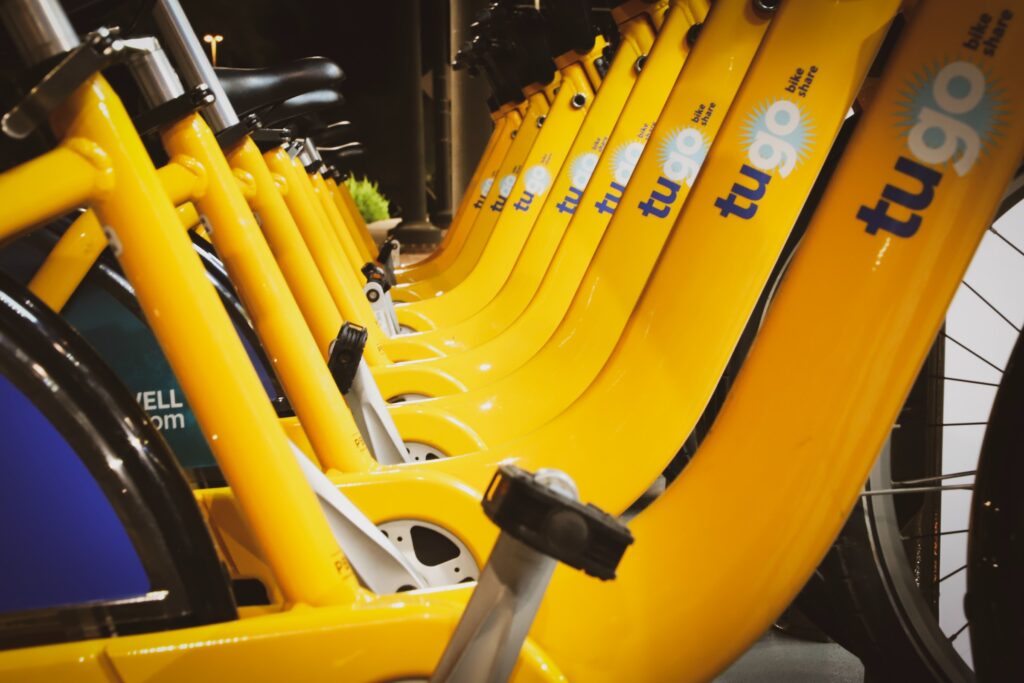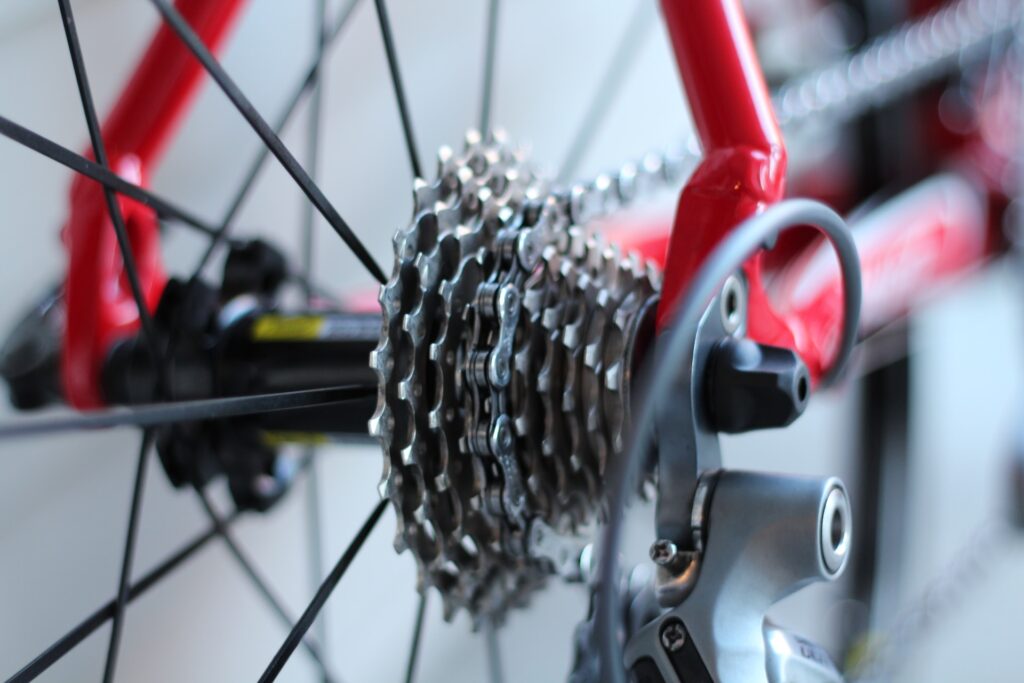If your exercise bike makes noise when pedalling, it might hint that something is wrong or broken with the machine.
Recognising which part causes the strange noise will need careful assessment. This is why seeking the help of an expert fitness machine technician is vital to help you resolve the problem fast and efficiently.
However, there are ways to identify the problems according to the sounds you hear.
Learn here to locate the source of the knocking noise on your stationary bike.
| Noise | Cause | Fix |
| Squeaks | Dry and dirty bearings | Clean and tighten |
| Worn brake pads | Clean the surface of the rim and apply a small amount of silicone spray. | |
| Clunking | Loose bottom bracket | Tighten the loose bottom bracket |
| Rattling | Loose chain | Adjust the chain |
| Tapping | Loose pedal from the crank | Put grease on the thread of the pedal and tighten it. |

Diagnose Why Your Exercise Bike Makes Noise When Pedalling
Exercise bikes can get worn out over time, and when they do, they try to communicate through creaks, squeaks and other strange noises. If your bike has been a little noisy lately, maybe it’s time for some love and care.
First, you need to know how to diagnose it by identifying where the sound is coming from. To do this, you need to pedal your exercise bike and listen to what type of noise your bike produces.
Below are some possible diagnoses:
1. Squeaks
A creaking or somewhat hit-pitched noise is often heard whenever you are performing intense cycling.
Possible Cause
Dirty and dry bearings or worn brake pads.
Possible Solution
For dirty and dry bearings, you can clean and add grease to your bike’s chains and bearings to ensure that they will function smoothly again. Tighten the hub nut if it is too loose but make sure you do not over-tighten it.
On the other hand, if the squeaking is coming from the wheel areas, it may be caused by filthy or worn brake pads.
You can fix this by cleaning the surface of the rim and applying a small amount of silicone spray. If doing these things does not resolve the squeaking noise, then you may need to replace the pads already.
2. Clunking
A clunking sound that occurs whenever you pedal. This sound may be a bit scarier than other noises because it can be very loud.
Possible Cause
Loose bottom bracket.
Possible Solution
To fix this problem, you must first remove the crank to tighten the bottom bracket. You will need to have bottom bracket tools to be able to tighten the bottom bracket cups. Contact a professional exercise bike technician if you are unsure of what to do or don’t have the right tools.
3. Tapping
A tapping or ticking sound on the bottom pedal whenever you are performing intense cycling.
Possible Cause
Loose pedal from the crank.
Possible Solution
Put some grease on the thread of the pedal after removing the pedal from the crank using a wrench. Reinstall by securely affix the pedal to the crank.
4. Rattling
Something is disjointed in your exercise bike when there is a rattling sound during pedalling.
Possible Cause
Loose chain.
Possible Solution
The chain tension can get loose over time so adjust the loose chain.
Loosen the cap nuts on the side of the flywheel using a wrench. Then tighten or loosen the nuts on the right and left adjusters using a socket wrench. Make sure you keep the flywheel in a central position.
To increase the chain tension, tighten the nuts on the bolts; loosen the nuts to reduce tension. The last step is to draw the caps on both sides of the flywheel using a socket wrench. Then you are done.

Prevention and Maintenance
Exercise bikes are relatively easy to maintain. It only requires very minimal yet regular maintenance to keep your exercise bike always in good condition.
1. Proper Storage
Store your stationary bike in a clean and closed space. Keeping your exercise bike outside is not advisable. It may be tempting to place your exercise bike in your garage, backyard or pool to save indoor space, but this may not be a good idea.
Some electronic and metal parts of the exercise machine may deteriorate quickly when exposed to external elements. Keeping it outdoors will also make your exercise bike susceptible to dust and may wear out some of its parts.
2. Periodic Cleaning and Lubrication
Daily cleaning for bike maintenance may be too much, but it actually will take you only a few minutes to do it.
Sweat (perspiration) can be corrosive and can damage parts of your machine. Do not forget to wipe down the frame, bike seat and handlebars.
You may use an antibacterial solution when cleaning your bike, however, a dry and damp cloth will work just well for daily cleaning.
It is also very important that you lubricate some parts of your exercise machine every week or month.
Lubricate the pedal bearing, pedal threads and brake pads to ensure that your stationary bike will always run smoothly. Other moving parts, such as the handlebar post, pop-pins and seat, will require occasional lubrication too.
It will also save you more money in the long run if you do periodic cleaning and lubrication because you are able to maintain the parts without replacing them or going to a professional exercise machine technician.
3. Avoid Over-Tightening Bolts and Screws
People who are inexperienced with fasteners tend to overtighten bolts and screws, thinking that tightening well would prevent them from loosening.
But that is not the case because over-torquing or over-tightening can cause snapped screw heads, stripped screws or damaged pre-tapped threading. Ensure your bolts and screws are not over-tight to avoid these problems.

4. Other Tips for Lessening Exercise Bike’s Noise
Exercise bike really does create sounds that may bother other people in your house or even your neighbours.
Some noises are due to machine problems, but some are due to riding your bike incorrectly or placing it on the wrong surface.
The noise you hear from your stationary bike during operation is normal. This is because the friction between parts can generate noises.
Below are some tips to reduce the noises you hear from your exercise bike.
- Place it on a concrete floor.
Place your exercise bike on a concrete or cemented floor for stability when you ride it. It would be best if the room you choose has thick padding or carpet to absorb the vibrations from your exercise bike.
- Place it on a thick rubber mat.
Rubber mats underneath your exercise bike can absorb even more noise. These mats can also keep your flooring from sweat.
- Ensure that your exercise bike is set up properly.
If your exercise bike shakes when riding it, it creates added noise. Ensure that everything is set up properly in accordance with the instructions of the manufacturer.
- Keep your chain always clean and lubricated.
The chain gets noisy when it is dirty. Your bike’s chain can accumulate dirt and dust over time. So ensure that you always keep it clean and lubricated to maintain a quiet and smooth ride.
Final Thoughts
A noisy bike can mean a lot of things, such as loose pedals or dirty bearings. Identifying the noises your bike creates can help you immediately fix the problem.
However, if you are not sure what to do or are not confident enough to fix it, hiring a professional machine technician is your best bet.
If you are looking for a new exercise bike replacement, head over to my list of the best exercise bike reviews to help you compare.
Related Questions
1. Do exercise bikes need regular servicing?
Just like any other exercise machine, your exercise bike receives a lot of impact when using it. Regular maintenance is needed to prevent your exercise bike from deteriorating quickly and to prolong its lifespan. You can do regular maintenance by yourself, but regular servicing is also beneficial if you want to ensure that your exercise bike always performs at its best.
2. What is the lifespan of an exercise bike?
An exercise bike’s lifespan depends on the type or brand you are using. It will also depend on how often you use and maintain it. However, the expected lifespan of stationary bikes ranges from 10 to 20 years. The average lifespan of a spin bike is about 10 years, with some models lasting longer or shorter.
- How Long Should You Stay in a Sauna Safely? - 20 January 2024
- Boost Post-Workout Recovery: Benefits of Using a Sauna for Recovery - 19 January 2024
- Discover the Health Benefits of a Low EMF Infrared Sauna - 19 January 2024
